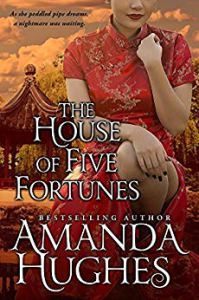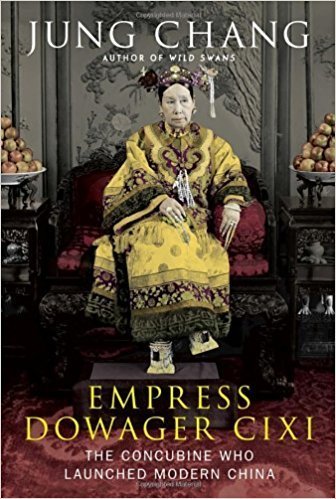Amanda Roberts's Blog, page 7
August 31, 2018
Interview With Amanda Hughes, Author of The House of Five Fortunes
 While Xiu peddled pipe dreams, a nightmare was waiting.
While Xiu peddled pipe dreams, a nightmare was waiting.
Sensual and exotic, San Francisco’s Chinatown in the 1870’s was filled with temptation and greed. Raised in this quagmire of vice, Xiu Jung caters to wealthy thrill-seekers with her elegant opium den, The House of Five Fortunes. With the help of Madison Hayes, the illustrious actor, she makes it the most fashionable salon on the West Coast. But a string of murders is sweeping the city, coming closer and closer to Xiu. Madison said he would protect her, but could this mysterious outsider be trusted?
From Chinatown to Deadwood, Amanda Hughes once again takes you on a page-turning adventure of a lifetime.
Interview with Author Amanda Hughes
Tell me a little about yourself, both personally and as a writer.
I have worn many hats in my lifetime from therapist to business owner to writer, but the role that has been the most rewarding and the most challenging has been the role of motherhood. I raised three children by myself (which makes me a “bold woman” too!) in the woods of Northern Minnesota. I spent many nights wondering where my next dime would come from but somehow we always made ends meet. Living in that remote location made me wonder how people survived the privation and violence of Colonial America so I was inspired to write my first book Beyond the Cliffs of Kerry. After many submissions, a publishing house in Canada bought the rights, and for several years Kerry was on the market. Unfortunately, the publisher closed their doors in 2004, and busy raising teenagers, I did not finish my second novel, The Pride of the King for almost ten years. The current Amazon platform was available by that time, so here I am eight novels later.
The House of Five Fortunes is part of your Bold Women of the 19th Century Series. What is that series and how did it come about?
Although I call it a series, my books are stand-alone novels. There are too many characters “waiting in the wings” for their tale to be told, so I could never dwell on one woman’s story. Thus, I don’t write sequels.
It took me a long time to realize that this was a series. After the third book, I started to see a common theme. The novels were always about gutsy, female survivors who lived in different time periods, so I called it “The Bold Women Series” and started organizing the books into centuries.
Tell me about The House of Five Fortunes specifically. How did you come up with the idea? What sort of research was involved?
Thirty years ago, I traveled to San Francisco and toured Chinatown. Instantly, I fell in love with the magic and mystery of the district. Years later when I decided to tell Xiu Jung’s story, I was disappointed to see so little had been written about the role of Chinese Americans in the building of the Transcontinental Railroad and the racism they endured. In knew then this story needed to be told, so I decided to share it in one of my “Bold Women” novels. To gain a deeper insight into the culture, I traveled to China, interviewed Chinese Americans with ancestors from San Francisco, and devoured every book I could find.
Many historical fiction authors focus on one place or era, but in your Bold Women series, you write about women from such diverse backgrounds. How do you manage that?
It is a labor of love. I cannot imagine being a writer of historical fiction and not loving research. I like to take little known time periods in American history and shed light on them. Time and time again we see stories about wealthy, beautiful aristocrats living on plantations, estates or in penthouses during the same old time periods. I think people living on the fringes of society in little-known settings are far more interesting. They are so often overlooked and have so much more to offer, so that is what I write.
What can readers expect from you in the future?
My latest work is about an American Indian woman riding the rails during the Great Depression. The book follows her rise to fame as one of the great photojournalists of the early 20th Century rivaling the likes of Dorothea Lange and Margaret Bourke-White. Her adventures take her from coast to coast and into Germany during the rise of The Third Reich.
Thanks a million for having me on your blog!
The post Interview With Amanda Hughes, Author of The House of Five Fortunes appeared first on Two Americans in China.
August 19, 2018
Guest Post – Business Strategy Lessons to Pick up From China
Every business has the same mission: reduce expenses and optimize revenue. But accomplishing this varies from company to company in different locations around the world.
Chinese companies are a great example. They are gaining ground on international corporations in the West. The consumer market in China differs greatly from the U.S. market, but American entrepreneurs can use some insights from Chinese businesses to get the extra advantage.
You Don’t Have to be One-Of-A-Kind
Entrepreneurs in China are bold in the business models they create. They are not fixated on starting with a unique idea so much as the processes behind it. Chinese business owners see imitating industry leaders as a learning source and a fast path to success.
They welcome innovation into a business philosophy of fast iteration. Experimenting with new ideas drives improvement through a constant cycle of innovation and assessment.
Their strategy focuses on providing “lean value“: basic designs tailored to a specific need. Customers want products that fulfill these needs and any extra features as wasteful.
One way to effect this in your own company is to seek customer feedback and innovate according to market demand. Companies in China use product reviews to drive design changes twice as often as U.S. companies.
You don’t need a perfect product to please customers, so long as buyers get what they’re looking for. Home-based businesses in America prove that the new generation of entrepreneurs appreciate this.
The launch of 38 million home businesses in the U.S. shows it’s possible to start small and build a stable company.
Think Holistic: View Your Business as One Entity
Chinese culture is fond of applying philosophical principles to many aspects of life, including business. Daoism teaches the only constant in the universe is continuous change. This can be a truism in doing business long-term.
What brings benefits today could create losses, and vice-versa. In China, specific strategies are not as important as the context in which they’re used.
A holistic approach emphasizes the relationships between different business functions, not the functions themselves. The parts are not separate from the whole. Your company is not a product or a service but a mix of all the components that make everything happen.
Look at your business model as the Chinese approach to traditional medicine. Physical illness is not a problem at one point, but an imbalance in the whole body. The body must restore that balance to work as it should.
When you assess your company, don’t fall into binary thinking; things are rarely black or white.
One of the best illustrations to grasp this mindset is the Chinese word for “crisis“. It’s formed of the two words – “danger” and “opportunity“. Recognizing the ambiguous nature of things allows the Chinese to merge opposites and create new perspectives.
Create a Plan for Long-Term Success
For Chinese business leaders, the most effective route to success is following the Five-Year Plan. They devote most resources to progress in strategic sectors.
The Plan identifies low-risk markets that fuel steady growth, a strategy favored by GE China, among others. This requires patience and vision. But, like most entrepreneurs, you’ll soon accept that there is no such thing as an overnight success.
Chinese companies emphasize fluidity. The ability to adapt as things change is vital even in the formalities such as business contracts. They do not define written agreements and inflexible as they are in the U.S.
Businesses in China do what is necessary to stay abreast of trends and meet the business needs. It’s critical to set goals, follow a plan, and keep control of all business operations to make it happen.
If the plan doesn’t work, change the plan; but never the goal.
The Chinese mind thinks of events as taking place over the long term. Looking well into the future can enable a clearer perspective on the present.
This helps curb the over-eagerness which leads to brash decisions and costly errors. You must learn to see all choices in a wider context and a more prolonged time frame.
Organizing Your Processes Makes Hiring Easier
Chinese industries have discovered that bigger operations are not necessarily better. It’s possible to make comfortable profits from a small team or even a solo home-based company. An expansion is not always the primary indicator of success for the entrepreneur.
The key to a stable business is improving control and quality and profitability maintenance. Doing this with patience and thoughtful planning supports steady profits.
When your company experiences growth, look to the Chinese model of building diverse teams, including foreigners in positions of leadership. This provides a wealth of experiences and a range of perspectives. It also creates a multinational environment better suited to producing global business directors.
Achieving this requires hiring to be as efficient and productive as other processes. Look to streamlining your onboarding to decrease lost time. A diverse business climate creates flexibility and freedom to embrace new opportunities.
Improving your hiring and recruitment starts with documenting your experiences. Get the information recorded to avoid repeating mistakes and to find what works best. Look at your operations in the context of digital agencies and hire remote workers to expand your talent pool.
Even with seamless hiring practices, not every employee will become a top performer, and some may prove to be a poor fit for your company. You can’t depend on posted resumes or interviews. Beneficial onboarding policies need not just fair and efficient hiring, but validation of experience, education, teamwork, and personal responsibility.
A Final Word
In summary, don’t be afraid to look abroad for business models to emulate. Even if you’re starting from the garage, it can pay to incorporate philosophies of Chinese industry. You can start your company off on the right track by implementing the ideas of patience, flexibility, profitability, and diversity.
Michelle Laurey is a telecommuting wordsmith who especially enjoys writing on a cloudy day. Always interested in ways which can help individuals reach their full potential in life, she enjoys producing stories on entrepreneurship, productivity, lifestyle, and health. Outside her keyboard, she enjoys visiting cozy coffee shops and taking long urban strolls with her boyfriend. Reach out to her on Twitter.
The post Guest Post – Business Strategy Lessons to Pick up From China appeared first on Two Americans in China.
August 16, 2018
Saving My Sanity With ASMR
A little over a year ago, I was teaching a writing class for an alternative healthcare university and one of my students wrote a paper about ASMR. I didn’t really understand what she was talking about and I had never heard of it before, so I did a quick YouTube search – and I was almost instantly hooked!
ASMR stands for autonomous sensory meridian response, and it usually refers to a tingling, relaxing sensation some people feel in response to certain “triggers,” such as having your hair brushed or having someone talk to you in a calming manner. Have you noticed that Bob Ross’s painting videos are suddenly extremely popular again? That’s ASMR! His calm voice and gentle movements are typical ASMR triggers. While the responses to ASMR videos can vary from person to person, the most common use for them is to help people go to sleep.
I have suffered from insomnia most of my life, but it seems to have gotten even worse as I’ve gotten older. Running my own business and having children certainly has not helped lower my stress levels! I’ve tried everything over the years to get more sleep, from medication, herbs, essential oils, masks, white noise, and more. And while some of these things work sometimes, nothing is consistent. But when I started watching ASMR videos, I was able to sleep without any other aids. And I think I finally figured out why.
When I try to sleep, my mind races. It doesn’t matter how physically exhausted I am, my mind just never shuts off. I have to constantly think about all the things I need to do, the books I need to write, worry about money, worry about my kid, worry about things I have zero control over…It’s exhausting. I’ve never been able to “meditate” because who can “empty” their mind? It simply isn’t possible for me. But I recently learned that “emptying one’s mind” isn’t possible for anyone. It’s a myth. Meditation is actually a heightened state of focus and awareness – not nothingness. Usually, meditation is intense focus on one thing instead of a million things.
This is where ASMR comes in for me. By watching a relaxing video, I am able to focus on THAT, instead of the million other things plaguing my mind, which allows my mind to calm enough to go to sleep. It has a similar effect on the mind as exercise. Exercise is often recommended to treat anxiety and depression, but it isn’t simply moving that treats the depression. Just walking won’t help calm your mind. You have to move fast enough that you are concentrating on your movements instead of whatever is on your mind. Basically, if you are able to think about what to make for dinner tonight while you are walking instead of focusing on putting one foot in front of another to keep from tripping, you aren’t running fast enough for the exercise to help with your depression. It’s a form of hypnosis, which is also just another form of heightened awareness and focus. ASMR, meditation, exercise, hypnosis – when it comes to relaxing and healing your mind, it’s all the same thing.
Since I started doing ASMR, I haven’t needed any other sleep aids. It has also significantly helped with my depression and anxiety. I still have some depression and anxiety, but it is far more manageable.
Interested in trying ASMR for yourself? There are countless ASMRtists on Youtube, and it’s important to find voices and experiences that work for you. But here are my top 5 favorite ASMR channels to get you started.
Gentle Whispering ASMR
Maria is the Queen of ASMR. She is a gateway drug. She did the explainer video at the top of the page. If you want to know “what is this ASMR thing all about?” check out her videos.
Latte ASMR
Latte does videos in English, Korean, and Japanese. She has the sweetest voice. She knocks me right out.
Goodnight Moon
Goodnight Moon has a really fascinating series of medieval characters that I just love. Her sets and stories are really enjoyable to watch. This is more like a TV show than ASMR because you really fall in love with the characters and can’t wait to see what will happen next, but it has the same effect.
The Lune INNATE
The Lune Innate is actually a distance Reiki healing practitioner, but her methods are very ASMR-like in nature. So not only can she help you go to sleep, but she can help heal your chakras as well.
Crystal ASMR
Crystal ASMR uses Reiki principles, but isn’t actually a Reiki master. But I really enjoy how short her videos are. If you just need something quick to get you to sleep, her videos are great to check out.
BONUS: Open Door Hypnosis
Open Door Hypnosis just announced that she is taking a YouTube hiatus, but you can still view her past videos to learn more about hypnosis and use it to fall asleep fast and deep.
What do you think? Have you given any of the above videos a try? Let me know in the comments!
The post Saving My Sanity With ASMR appeared first on Two Americans in China.
July 27, 2018
The Blessings and Curses of Working From Home
Working from home is great. I roll out of bed and can get right to work. I don’t have to worry about wearing “work” clothes, doing my makeup, or even brushing my hair. I have access to my tea, my snacks, and my dog. When my daughter comes home from school, I’m here for a kiss and a “how was your day” before she goes to play. If I need to, I can have a nap. Or I can take a break and watch a new episode of whatever new TV show we are watching. I don’t have to eat out or worry about paying rent on an office or buying gas to get to work.
It’s fantastic!
It’s also the literal worst. I haven’t left my house for five days. I’m not sure when I last showered. I haven’t spoken to a person I’m not related to face to face for weeks. My husband says I need to get out and make friends.
But I love my job! I really enjoy what I do. When I wake up in the morning, I have no problem getting out of bed because I can’t wait to check my book stats from the day before and getting started on hitting my word count goals for the day.
Sometimes I do feel a little lonely and like I’m not getting the most out of living in such a fantastic place. But leaving the house is hard for me. Going out means spending money, and I’m in a saving/get the credit card paid off mode right now. Getting out also means that everything I need to get done isn’t getting done. I’m not just a writer, but a teacher, editor, and publisher. I do have a lot on my plate. I love it, but it can be stressful, and it’s hard to unplug.
I’m trying to find more of a balance, but it’s difficult. I just want to work, work, work!
What about you? If you work from home, how do you find the motivation to “get out”?
The post The Blessings and Curses of Working From Home appeared first on Two Americans in China.
July 4, 2018
100 Things I Love About China
I usually look forward to the 4th of July, but I don’t think America deserves to be celebrated right now. And while there is plenty to criticize China about, there is a lot to love about this country too. So here is a list of 100 things I love about China – in no particular order.
Adorable babies
The people
dumplings

embroidery
calligraphy
ink and wash paintings
shadow puppets
Hong Kong
Hongkongers
Bruce Lee
Jet Li
Ang Lee
12 Girls Band

the erhu
terracotta warriors
5,000 years of history (give or take a thousand years)
hotpot
Sichuan food
Yangshuo
Yangshuo’s karst mountains
river cruises
Prince Gong
Empress Cixi

The Forbidden City
The Great Wall
granny dancing
domestic helpers
not needing a car
fast trains
C-trip
not having to tip
taxis on demand
low cost of living
my daughter’s school
taobao
meituan
Zhang Ziyi
Lang Lang
Donnie Yen
Jackie Chan
Chow Yun-fat
the ability to travel around the rest of Asia cheaply and easily
The Feminist Five
Qing Dynasty-era manor houses

unique architecture
pandas
dragons
phoenixes
Chinese graves
Zhangjiajie
noodles
Muslim food
street food
night markets
ethnic minority cultures
Dafen Artist Colony
traditional artisans
temples
countryside hostels
Jung Chang
Xinran
affordable medical care
a general feeling of safety
Lantern Festival

Chinese New Year
floating lanterns
Singles Day Sales
Lion Dancing
Chinese Weddings
Hongbaos
Traditional Chinese Clothes
watching China change from the inside
watching the rest of the world change from the outside
shops open late and on weekends
local parks
tea
acupuncture
kungfu
Chinese opera

cheap internet/phone service
meeting people from all over the world
endless opportunities
The way Chinese youths are creative and innovative
assigned seats in movie theaters
silk
the Chinese zodiac
fireworks
Ning Zetao
only one time zone that never changes
Shanghai
Chinese acrobats
Zigong Dinosaur Museum
Lhasa
Splendid China
Anything made of jade
KTV
Toys-R-Us (Yup, we still have them over here!)
Chinese Court Dramas

chopsticks
There are many more things I love about China, but that is enough for now.
What do you love about China? Let me know in the comments.
The post 100 Things I Love About China appeared first on Two Americans in China.
June 28, 2018
The Children Everyone Wants
“Why do you want to adopt a baby no one else wants?”
This is one of the most common and offensive questions when it comes to adoption. Many people are genuinely curious about the adoption process, which is understandable, and I’m happy to help educate people about the joys of building their family through adoption. But the idea that adopted children are people “no one wants” is wrong.
While some birth parents might give up their children because they weren’t ready to become a parent, for the most part, parents who put their children up for adoption here in China want to keep their children. Birth control pills, condoms, and abortions are all readily accessible here. And while China’s sex-ed is lacking and unwanted/unexpected pregnancies do happen, almost 100% of children who are abandoned here in China have a significant special need. These parents want to parent their children. It is only because of extreme circumstances that they are forced to relinquish their kids.
There are two main driving forces resulting in abandonment and adoption in China.
The first is China’s family planning policy. Once a one-child policy, now a two-child policy, it really doesn’t matter how many children the government wants to include in their draconian method of unnecessarily controlling the country’s population. By limiting how many children a family can have, parents are forced to make horrifying choices that most of us in the world can never imagine.
You might be able to sit in the comfort of your home and think, “I could never give up my child just because the government told me to,” but you’ve never had the government actually tell you that. If a government official came into your home today and told you that if you didn’t give up your much-loved second child, you would lose your job and your home, you would not be able to access healthcare, and your other child would not be able to go to school, what would you do? Really? Again, it is so easy to say, “I’d rather be homeless” when you have a home. I know this sounds like something out a dystopian novel, but it has been going on here in China – for every single family – for more than thirty years. Countless loved, wanted children have ended up in the adoption system because of this disgusting policy.
And the family planning policy extends to adoption. There are actually many families in China who would love to adopt but can’t because they already have one or two children. Chinese adoptees are not “unwanted” by their birth families or by Chinese adoptive families – they are simply not allowed to stay with their families or be adopted. In Xinran’s book Message From An Unknown Chinese Mother, she gets deeply personal about her experience trying to adopt a little girl after she had already given birth to her son.
Being forced to have only a limited number of children feeds directly into the second reason many children are abandoned in China – no access to medical services for children with special needs.
Here in China, it is extremely rare to see people with disabilities. I can count on one hand how many people in wheelchairs I have seen. Or blind people. Or people using sign language.
This is a bit of circular reasoning. In China, there are no services for disabled persons. For example, there are many places you simply cannot access if you are in a wheelchair. Therefore, you never see disabled people in public. So why build services for disabled persons if there aren’t any in public? But you never see them in public because there are no services for them…and so on.
When it comes to having children, many people realize the difficulties that people with disabilities face. Chinese families also have a very dependent set-up. There is no social security system from the government or retirement benefits from your employer. Parents raise their children, and the children show thanks by supporting their parents in their old age. If a child is born with a disability, the likelihood that the child will then be able to earn enough to support their parent later is greatly diminished. So many children with disabilities are abandoned at birth or abandoned later if a healthier sibling comes along.
Even if a family wanted to keep the child with a disability, as I already said, the services don’t exist. Where we currently live, speech and physical therapists don’t exist. And even if they did, many people won’t know what they are, how to access them, or be able to afford them.
Even though my husband and I have access to top quality medical care and have the money to pursue it, raising a child with special needs is hard. There have been many days when I have felt frustrated and alone and worry about our daughter’s future. I can’t imagine the agony our daughter’s birth parents endured before they made the painful decision to let her go.
So before you think – or hear someone else say – that an adoptee was “unwanted,” stop. The child was probably desperatly loved and wanted by far more people than you realize.
The post The Children Everyone Wants appeared first on Two Americans in China.
June 22, 2018
Interview With Alexa Kang, Author of Shanghai Story
Alexa Kang is the author of the amazing new book Shanghai Story, and I am so thrilled that she agreed to answer a few questions for me. I hope you enjoy this interview and will check out her book.
A WWII saga in the heart of the world’s most decadent city in 1936. Enter the Paris of the East, where one man and one woman strive to hold on to their dreams as the Communists rise and the shadow of Japan closes in.
His country stood on the verge of a new beginning and the gate of hell. The Kuomintang promises the dawn of democracy, but the Communists threaten civil war while Japan’s unbridled ambitions loom.
All Clark Yuan wants is to see his fellow countrymen’s lives improve. He joins the KMT, hoping to play his part to make China a better place. He vows to Eden, the beautiful Jewish girl he admires from afar, Shanghai would be her forever home.
But power and money are at stake. The line of good and evil shifts. To achieve his ends, he must bargain with the devils. How much of his soul would he sacrifice to reach the greater good?
*
Fleeing the rise of the Nazis, Eden Levine came with her family to Shanghai, hoping to build a new life.
The dazzling city made her swoon. From the pinnacle of luxury, big band jazz, to a safe haven for Jewish refugees, the country that turns no one away is the beacon of hope. But behind the glitz and glamour, the darkness of human nature lurks.
A heinous crime shocks the international community.
Would she defend an innocent Nazi soldier and risk the ire of her own people? With only her new friend Clark by her side, could she defy the clutch of racial strife to see justice prevail?
AMAZON
Interview
1) Tell me a little about yourself and your writing history.
 I’m Alexa Kang, WWII historical fiction writer. I started writing fiction three years ago as a hobby. Back then, I wrote fanfiction for an obscure, out-of-print Japanese manga called Candy Candy with a die-hard international following. My fanfic stories were very well-received. A fanfic novella I wrote was translated into French, Italian, and Spanish by fans from different countries who loved the story. After that, I decided to give serious novel writing a try.
I’m Alexa Kang, WWII historical fiction writer. I started writing fiction three years ago as a hobby. Back then, I wrote fanfiction for an obscure, out-of-print Japanese manga called Candy Candy with a die-hard international following. My fanfic stories were very well-received. A fanfic novella I wrote was translated into French, Italian, and Spanish by fans from different countries who loved the story. After that, I decided to give serious novel writing a try.
I released my debut novel, Rose of Anzio (Book One), in 2016. It’s a WWII epic love story that begins in pre-war Chicago and continues onto the Battle of Anzio in Italy. My fanfic readers were my earliest supporters as I shared my novel with them chapter-by-chapter as I wrote. From their responses, I knew I had a special story to tell. After it was published, I received emails from new readers who had lived through the WWII era asking when my next book would come out. One even worked in Chicago in 1940, which was when Rose of Anzio Book One took place. Those readers are in their nineties!!! It was such a humbling experience to hear from them.
I’ve been an incredible journey ever since. The most satisfying reward for me is knowing that I’m able to give people a few hours of escape from their daily burdens through my stories.
2) How did the book Shanghai Story come about?
I’ve gotten to know many WWII fiction authors since I started publishing, and I keep up to date on new WWII novels being released. WWII is a popular genre, but rarely do I see any WWII book set in Asia. WWII fiction set in China is almost non-existent in English or Chinese. I did find a few English novels set in China during WWII, but they aren’t about WWII. I started thinking maybe I could write one.
Nonetheless, I’m not a writer who can pick a topic and plan a book. I can only write something when a character comes alive in my head. This finally happened when I saw a young Chinese man returning to Shanghai from studying abroad. I saw him disembarking a ship on the Bund with hopes of helping to modernize his country into something like America, where he’d gone to college. This young man was Clark Yuan, the main character in Shanghai Story, and this is his story.
3) What was it like researching this book?
Researching is always one of the toughest parts of writing historical fiction. It’s very work intensive. For Rose of Anzio, I had a lot of great resources to go to because WWII was very well documented by the Allied countries. China is a different story. The Nationalist government back then was very backward in technology and lacking in funds. They didn’t keep very good historical records. Even if there were records, most were lost or destroyed when the Communist Party took over. The CCP has no interest in glorying a war won by the Nationalist Party, and they have their own biased spin on what happened anyway, so research was very challenging.
Fortunately, I can read Chinese, so I was able to research in both Chinese and English. For the macro history side, I tracked down the most objective secondary sources I could find. I also visited the Shanghai Jewish Refugees Museum to gather information on what life was like for the Jews and how people lived in Shanghai back then. My late grandmother lived through WWII China too, so I was able to draw on my own knowledge of the Chinese culture in the past to write this book.
4) Writing historical fiction can sometimes seem like a daunting task. Did you face any particular challenges while writing this book?
Aside from the difficulties in research, my own biggest challenge was writing an Asian male main character. How do I make him attractive and relatable to a primarily non-Asian readership, and include him in an AMWW (Asian Man/White Woman) romance subplot? For all the recent talks about diverse writing and representations in media, Asian men generally do not get a lot of love in American media (John Cho and Daniel Day Kim notwithstanding). Pairing an Asian man in a romantic role with a white woman (Jewish in my case) is still a rare phenomenon. I wasn’t sure if readers would be interested in reading a book in which the hero is an Asian man.
On the other hand, I’m not a writer who use my books to force messages onto readers, nor do I want to write for the sake of “representation.” I really, really dislike doing that. As a historical fiction writer, my primary goal is to tell a good story and take my readers on an emotional journey. I do my best to present history objectively so readers can see and experience the world in that era for themselves. I want them to have the opportunity to judge history through their own eyes, and not what I tell them.
Anyway, I couldn’t have written a story to make a point even if I tried. My writing process is very organic and I don’t plot before I write. I write because characters invade my mind and won’t let me rest until their stories are told. Clark and Eden happen to be the ones occupying my head at the moment. I only hope that I’ve done their story justice. I hope Clark will come across to the readers as someone they can relate to, and they can feel all his joys and pains.
5) What is your favorite scene from the book?
My favorite scene is when Clark and his sisters took Eden to the Paramount Dance Hall. So much of what the entire story is about was embodied in that scene. The Paramount was the epitome of 1930s Shanghai decadence. The performers that night were Buck Clayton and Zhou Xuan. Through Clayton, I was able to show readers the influence of Black American jazz on Chinese contemporary music, as well as the racial attitudes and segregation during that time. Through Zhou Xuan, I introduced to readers an icon of modern Chinese music. She performed “When Will You Come Again?” This song is very popular even today. What most people don’t know is that this song has a huge cultural, historical, and political significance. It was first banned by Chiang Kai-shek, then by the Japanese, and then by Mao’s Communist Party. I really like sprinkling into my books details like these ones.
In that scene, we saw a glimpse of the Communists’ views on commercialism through Liu Zi-Hong, the boyfriend of Clark’s sister Wen-Li. The Japanese captain Kenji Konoe made an appearance and we got an allusion to the looming Japanese threat. Most important of all, it was a major scene where we could see Clark and Eden’s deepening attraction to each other, and how the constraints of racial and cultural divide prevented them from pursuing a relationship.
I hope your readers will enjoy Shanghai Story. Thank you so much, Amanda, for giving me this chance to share my thoughts with your readers.
The post Interview With Alexa Kang, Author of Shanghai Story appeared first on Two Americans in China.
May 29, 2018
Separating Children From Their Parents Is Wrong
The focus of this blog is usually politics and social issues here in China, since that is where we live. But we are also Americans, and we very actively follow politics back home. This is not just because we are interested in what is going on back in the States, but because as American citizens, the actions of our government impact us in very real ways every day. So some things that are happening in America I just have to talk about.
The separation of migrant children from their parents at the border is horrifying, disgusting, and wrong, and America – and anyone who supports such policies – should be deeply ashamed.
Let me tell you a story.
About four years ago, while driving his motorbike to a dentist appointment, my husband was pulled over by the police in Shenzhen, put in the back of a police car, and taken to jail. I was able to find him at a local police station where Zoe and I spent several hours, until almost midnight, trying to get him released to no avail. Eventually, I had to watch my husband put in the back of a police van and be driven away.
I had no idea where he was going, what would happen to him, or when I would see him again.
We were told he would only be detained for ten days, but that after that he would be deported. I called the consulate in Guangzhou the next day and they sent a representative to the jail to talk to him. He mentioned at one point that while my husband should only be held for ten days, they could “escalate” the case and hold him indefinitely, so he should be on his best behavior.
We were both frantic and terrified. It took several days before I was even able to see him and make sure he was okay, and then we could only talk for ten minutes.
 The next ten days were true hell. I called everyone I knew, begging for help. I talked to dozens of people and had to make many trips to the bank to collect enough funds to pay certain people to help us. When I wasn’t working on securing my husband’s release and trying to keep him from being deported, I was physically sick in bed. I couldn’t function. I ended up having to take the two weeks off of work because I couldn’t think of anything except my husband.
The next ten days were true hell. I called everyone I knew, begging for help. I talked to dozens of people and had to make many trips to the bank to collect enough funds to pay certain people to help us. When I wasn’t working on securing my husband’s release and trying to keep him from being deported, I was physically sick in bed. I couldn’t function. I ended up having to take the two weeks off of work because I couldn’t think of anything except my husband.
And I was out. I was home. I had food to drink and Zoe to take care of me. What I went through was nothing compared to what my husband experienced inside a Chinese jail – but that is his story to one day tell.
In the end, my husband was released at 9 am on the 10th day and wasn’t deported. We survived and my husband sometimes tells other people about the experience at parties.
But it was a deeply traumatic experience. We still have separation anxiety and minor panic triggers related to those ten days.
And we are fully functional adults. I cannot imagine going through the same experience as a child. Of having your father or mother ripped away from you, not knowing when or if you will see them again.
While visiting my husband at the jail, I saw many mothers on the inside being visited by their children (the jail had a woman’s ward as well, mostly for prostitutes), who were often crying. I can’t imagine the terror those children must have been facing at being separated from their mothers even for a short amount of time.
I know that my experience in no way compares to what immigrants to America are facing today, but it did make me much more empathetic to their plight. That anyone thinks it is “okay” to separate families, even for a short amount of time, is unfathomable to me. Who are these soulless monsters?
Being an adoptive parent has also made me much more aware of the long-term damaging effect trauma can have on a child. All adoption starts from a place of loss and trauma that can manifest in many ways throughout a person’s life. Even someone adopted as an infant can experience loss and trauma. Trauma can even be inherited from generations in the past. That the US government would willingly inflict separation-induced trauma on children is abhorrent. To say nothing of the trauma inflicted on the parents. I can imagine nothing more horrifying than having my daughter taken from me.
Even though I am adoption advocate, I am a family advocate. We should all be taking every step to keeping families together. Family separation should only ever be a last resort.
The post Separating Children From Their Parents Is Wrong appeared first on Two Americans in China.
May 13, 2018
Guest Post – Stop Panicking. Launching a Webshop in China is Easier than It Looks.
For many western brands, China could be one of the only few markets that brings about very strong mixed feelings. On the one hand, you can effortlessly find on pretty much all the major news outlets jaw-dropping stories about how some Western brands are making millions, if not billions, in China’s online world. On the other hand, just the thought of opening up a webpage filled with Chinese characters or speaking to a rude and sometimes unprofessional Account Manager from one of the large eCommerce companies may already give you a headache. And I have not even started with the censorship. However, China is also no mystery. Just like doing business in all other emerging markets, you just need to figure out what is the magic button.
When thinking of China eCommerce, the first thing that pops into your mind might as well be Alibaba or Jack Ma. Indeed, Alibaba keeps surprising the world with its strong capacities to engage Chinese e-shoppers and to monetize their shopping sprees. On the 2017 edition of Singles’ Day, it only took Nike 59 seconds to achieve a gross merchandise value of 100 million CNY or 13 million EUR. As a result, such B2C marketplaces are still the top choice for market entry to China’s ever-evolving eCommerce world as they account for majority of Chinese consumers’ online shopping activities.
Over time, Chinese millennials, or the post-80s/90s generations, are taking over as the main force that drives China’s consumer market forward. They are well-educated, demanding, and suspicious. It takes more than product reviews or a simple KOL live streaming show to convince them that your brand is worth their attention. What they ask for, probably without realizing it themselves, is a complete and topnotch online touching point experience. Many Western brands, larger or smaller, are racing to deploy a multichannel online experience.
In a consumer study by iResearch, stand-alone brand websites come in 3rd, right after eCommerce marketplaces and offline stores, as the most often used information channels for Chinese e-shoppers.
So to launch a standalone brand website would be a crucial part of a winning China eCommerce strategy. There can be many benefits of having an official brand website, with or without shopping functionalities— among which are greater exposure opportunities, positive associations, higher retention rates, and diversified investment portfolios. Yet, the most important benefit of having a standalone website would be the ability to test, experiment, validate all your hypotheses. It may sound like a “moo point” to you but please keep in mind that the marketplaces, like JD, Tmall, and Suning, all have very strict rules on your webshop layout, UX model, product offerings, and so on; all of which means very little room to be creative and flexible.
How the crocodiles do it?
Below are a few cases in which Western brands are making use of their websites for something otherwise either taboo or simply impossible on Tmall or JD.
Adidas. Adidas has launched the customization services, Miadidas, on their standalone website. It’s rather unimaginable that a Chinese marketplace could break their own rules to allow companies offering such services.

Lancôme. The French luxury giant integrates their e-Magazine on their official eCommerce website, as an additional benefit. The customers can still have almost the same shopping experience with the brand store on Tmall/JD.

IKEA. IKEA integrates their own membership system with what looks like a pilot eCommerce website as they can only ship to customers in Shanghai, for now. By joining the membership online, one can shop with the member-only price both online and offline.

Again, these benefits may seem trivial on the Western standards. When it comes to China eCommerce, the tradeoff between channel adoption – what a marketplace can GUARANTEE –, and freedom to CUSTOMIZE, – benefit of having a standalone website-, has always been a pickle for eCommerce Managers accustomed to Western landscapes.
Since the past few years, we have seen an increasing number of brands utilizing both eCommerce channels. It seems that more Chinese consumers are accepting standalone websites as a credible sales channel—both Adidas and Lancôme have achieved a month onsite traffic higher than 2 million already. Indeed, why not to become a front runner and have both—a well-operated listed Tmall store and a well-crafted standalone website?
Powering through your project in baby steps
Then, the question becomes how? Well, launching a website in China can be a bit different from the Western norms. They are usually seven steps before you can start directing traffic and improve engagement intensity on your website:
Step 1. Getting the right legal documents
The Chinese government requires all companies hosting a website in China to have the Internet Content Provider certificate. To acquire this certificate, a Chinese Business License is required.
Having troubles with applying for the Chinese Business License? Hosting in Hong Kong can be a quick-and-easy solution. Alternatively, you can look up webshopinchina.
Step 2. Confirming your objectives
It is advisable to start this step by reviewing your internal resources—Marketing, Merchandising, Fulfillment, IT and Customer Care, to name a few. Then, project scoping is of utmost importance—you would need to make sure all your objectives are mirrored by the corresponding designs or features and all the redundant ones are left out. After all, missing out important features will render the whole project valueless, while being a scope creep would cause otherwise avoidable delays. In addition, doing competitive analysis, conducting user research, and planning marketing/sales efforts in this step is also highly recommendable, if not absolutely necessary.
If you are still new to China, then a website alone may NOT offer the greatest sales prospects at first. Instead, it’s advisable to focus on rolling out compelling contents—nice stories, videos, and/or interactive campaigns made with HTML5 webpages—that can faster gain trust from your consumers. You might also want to ensure that Instagram, Facebook, and YouTube, are all replaced with Weibo, WeChat, Tencent Video and/or Douban.
It’s also advisable to work with a Chinese partner just to ensure that you are putting the “correct” priorities in your wish list. Before diving into the development process, have your IT staff and partner to work on a list of toolkits that have Western equivalents and are available in the country. The ones you have possibly taken for granted for might not be accessible from China.
Please also keep in mind that Chinese consumers can be a bit more difficult to impress than you were expecting. Stereotypes such as the Chinese prefers more text, screaming designs, and tacky visuals should be put to a non-recyclable trash bin forever. At this point, it’s better to have your Chinese partner or Chinese speaking staff to perform a competitor analysis summarizing a UX model that your top 5 competitors are seem to using.
Step 3. Development
Next, registering domains, visual designs, and backend development will be main deliverables. Closely communicating with your IT vendor and monitoring the project rollout is an important task. Plus, you should definitely spend time maintaining, updating and circulating all documents created in the previous step. All stakeholders, internal and external, should stay on the same page at all time.
As over 80% of online transactions in China take place on mobile devices now, you would also need to make sure that your partner will make the site fully responsive to mobile devices.
Step 4. Pre-launch
You don’t have to launch your website after everything is done to perfection. In fact, it’s recommendable to launch a semi-finial version and let your audience tell you if the current version is a keeper or not. But needless to say, SEO proofing, User Acceptance Tests, and other QA measures should be performed whether you are going lean or sticking to the classic way.
Before (lean) launch, you might also want to consider using some of the UX applications to monitor user interactions and elicit visitor insights.
Step 5. Maintenance, Optimization, & Integration
Post-launch maintenance should not be neglected in any way. It’s one thing to protect your website from virus, hackers, and breaches. It’s another to make sure your product offerings, contents, and designs are up to date and everything in the backend is working properly.
Make sure your Chinese partner has registered your website at Baidu, Sogo, and/or 360 and start building your e-reputation by crafting a Baidu Knows page, starting a stream on Zhihu, the Chinese Quora, or planning Baidu PPC campaigns.
You should also have your Marketing staff or your Chinese partner report to you weekly how the website is performing. It’s advisable to use Baidu Analytics but Google Analytics may also do the job, if you insist. One or two times of (micro) optimization is recommended every one to three months. It cannot be overemphasized how important it’s to keep your site not just nice and shining but also relevant.
That will be all for now. Hope you have a better idea about how to get a well-functioning standalone website in China!
Want to know more about Chine eCommerce? Leave your email address below and I will send you our practical guidebook of setting up an online store or a standalone webshop in China today.
Not for publication: the contents above, including text and banners, are not for commercial publication. Full copyrights of the above contents, including text and banners, belong to WebshopinChina BV. For inquiries on media partnership, please contact the writer Zi Wang at zi@webshopinchina.com .
Zi is an eCommerce Specialist at WebshopinChina.com.
The post Guest Post – Stop Panicking. Launching a Webshop in China is Easier than It Looks. appeared first on Two Americans in China.
April 29, 2018
Guest Post: 5 Tips on Starting a Business in China
It’s said that 80 percent of new businesses fail within two years. Launching a company in a foreign culture makes the challenge even more difficult. But if you do your homework and cultivate your patience and will power, you can start a successful business in a strong market such as China.
Do Your Research
One of the first things you should do is become familiar with the five-year plan published by the Chinese government. Among other things, it outlines the type of businesses they welcome. This makes it easier if your industry falls into these categories.
Outsiders have been trying to grab a share of China’s booming business climate for decades. There are people all over the world who might share stories of successes and failures that can serve to guide your decisions.
One of the best ways to meet these people is to attend of China’s five major trade shows:
Beijing Auto Show
Shanghai Import and Export Commodity Fair
Canton Fair
Yiwu Trade Fair
Bauma Fair
What takes place at these shows is growing in influence as Chinese technology and the Chinese economy continue to improve.
Hire a Local Consultant
China’s economic growth in 2016 was 6.7 percent, exceeding expectations, and its disposable income grew accordingly. While the Chinese business markets continue to improve, there are still many challenges facing entrepreneurs who wish to establish a presence in China.
One step in ensuring a smoother process is to have someone with experience to advise you on registering a company there. A Chinese business consultant can help with filing the correct paperwork and act as your agent when you’re away. However, it’s up to you to do your diligence in finding an experienced consultant to work with.
Decide on a Type of Business Entity
In general, there are three business legal entities that entrepreneurs choose for operating a company in China.
Representative Offices
This is just what it sounds like, and not a separate legal entity from a parent company. As a result, there are certain limitations in China, particularly not being able to accept payment directly from Chinese clients. This is appropriate for something like a marketing or informational office. However, the Chinese government still expects you to pay taxes on any income that’s generated.
Joint Venture
A joint venture is a company controlled in a partnership between foreigners and Chinese business people. It’s usually associated with tech startups. Given the ongoing problems with protecting intellectual property in China, this could be risky. However, if your product falls into a specific category, such as a software release whether on or offline, you may be “restricted” so that a joint venture is your only option.
Wholly Foreign-Owned Enterprise
This is any company in China that’s wholly owned by foreign investors. It commonly takes the form of an LLC, or limited liability company, where each partner’s share is proportional to the amount of their investment. Depending on the nature of the company and the province where it’s located, you might also be required to register a bank deposit to ensure the payment of dividends. There’s also a complex legal process should you later decide to sell the company.
Work More. Work Fast.
 In the U.S., it’s customary for employees to work a 40-hour week, eight hours a day. Chinese workers are used to 12-hour shifts, including Saturdays. Even if you want to call in your team for a Sunday meeting, it seldom raises complaints.
In the U.S., it’s customary for employees to work a 40-hour week, eight hours a day. Chinese workers are used to 12-hour shifts, including Saturdays. Even if you want to call in your team for a Sunday meeting, it seldom raises complaints.
This additional labor time means you can carry out more projects and complete them more quickly.
However, it’s not unusual for a change in business strategy to happen after hours, depending on the situation, when you’re already home for the night. It’s even more important to implement efficient operational processes. Employees in the U.S. should be able to communicate, share data, and coordinate their efforts with their Chinese counterparts at any time in the course of project development.
Hiring in China
The employment scenario in China is rather different than American executives are used to, so it might be a good idea to work with a hiring agency or consultant in China. An alternative is to hire someone in the U.S. who’s experienced with Chinese business practices and instruct them in your company mission and values before sending them ahead to start recruiting on your behalf.
Ideally, this person should be fluent in Chinese, but that’s secondary to the need for real business acumen. This is vital, because they’ll essentially be building your company from the ground up on Chinese soil.
With a trusted manager in place, you can start developing your workforce to encompass the skills and talents you need. You should also stress the importance of signing contracts and publishing employee handbooks or codes of conduct that cover disciplinary actions such as firings. If you don’t, you could find it difficult to fire anyone without facing a lawsuit in the Chinese courts.
To sum it up, China’s booming economy and technology pose a significant opportunity for foreign business leaders. To succeed, however, it’s essential that you’re familiar with Chinese laws, as well as conditions in China regarding labor practices, and able to communicate effectively. Whether you hire consultants or work out the details yourself, there’s potentially a huge market there for Western goods and services.
Jen McKenzie is a self-employed author hailing from New York, NY. She writes extensively on business, education and human resource topics. When Jennifer is not at her desk working, you can usually find her hiking or taking a road trip with her two dogs. You can reach Jennifer @jenmcknzie
The post Guest Post: 5 Tips on Starting a Business in China appeared first on Two Americans in China.




